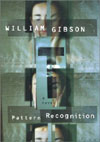
Comment
on this story
|
 |

William Gibson adroitly investigates branding in Pattern Recognition
by Jonathan Frey
William Gibson traffics in global signage, his oeuvre littered with commercial symbols, logos, trade names—real and imagined, obscure and apparent, the regionally adjusted literary equivalent of billboard-strewn route 441 on a summer weekend.
In a Gibson fiction, a traveler fishes a Bic from her TUMI while sipping Apollinaris on the THY redeye to Ankara. Objects become their logos, commercial synecdoche alluding to unexplained and murky attributes, a prose style that risks both cliché and opacity. To a marketing type, it's all product placement, complete with undertones. In a Gibson novel, it acquires a sinister quality, as if Gibson recognized a quarter of century ago what the rest of us have just cottoned on to: what binds our society are our mutually recognized symbols, but the only symbols our brave new global society universally recognizes represent multinational corporations and their products.
Given such a literary tic, it was only a matter of time before Gibson created Cayce Pollard, the female protagonist of his latest novel, Pattern Recognition (Putnam, $26). Drawn from William Gibson central casting, Pollard is like so many of his previous heroes: a sensitive soul, endowed  with a gift, a unique insight. Pollard's is logo synesthesia, one who keenly "experiences" commercial branding, and as a consequence is characterized a "dowser in the world of global marketing." Unfortunately, her uncanny and lucrative flair for immediately recognizing whether a brand logo will work has unfortunate side effects, most notably manifested in phobic reactions to certain brands. Cases in point are Tommy Hilfiger ("simulacra of simulacra of simulacra") and Bib, Michelin's otherwise benevolent stack-of-radials-like mascot ("bloated, maggot-like"), which incite in Pollard incapacitating disorientation. Another quirk is that Pollard removes commercial labels from all her possessions, yet nevertheless assists corporations in identifying new trends to brand. In this, Pollard is both global branding medium and, paradoxically, its antidote. A more apt character never graced a Gibson novel's pages. with a gift, a unique insight. Pollard's is logo synesthesia, one who keenly "experiences" commercial branding, and as a consequence is characterized a "dowser in the world of global marketing." Unfortunately, her uncanny and lucrative flair for immediately recognizing whether a brand logo will work has unfortunate side effects, most notably manifested in phobic reactions to certain brands. Cases in point are Tommy Hilfiger ("simulacra of simulacra of simulacra") and Bib, Michelin's otherwise benevolent stack-of-radials-like mascot ("bloated, maggot-like"), which incite in Pollard incapacitating disorientation. Another quirk is that Pollard removes commercial labels from all her possessions, yet nevertheless assists corporations in identifying new trends to brand. In this, Pollard is both global branding medium and, paradoxically, its antidote. A more apt character never graced a Gibson novel's pages.
Pollard is hired by a London advertising guru, with the wonderfully descriptive and Dickensian name of Hubertus Bigend, to chase down the author of "the footage," a series of short video clips anonymously and intermittently released to the Internet. In signature Gibson style, the clips are never fully revealed to the reader, but are clearly a global phenomenon, their simultaneously specific yet general nature gossip fodder for groupies, businessmen, cultural theorists, assorted hangers-on, and chat room denizens worldwide, many of whom, like Cayce, convene on Fetish:Footage:Forum to propose and hotly contest each new clip's significance, the possible narrative they form, the pattern in their release, the nature of the author(s). Collectively the clips represent an innovative and contradictory publicity coup, anonymous yet hugely popular, brandless but universally known, of great interest to all but financially benefiting apparently no one, and consequently of enormous interest to Bigend.
Gibson situates this oxymoronic twosome, anti-logo marketing-savant and sponsorless footage "promotion," firmly in the present—a first as his former novels have been set in a just-beyond-the-horizon future (often dystopian), or on one occasion in an elaborately contrived past. Rather than employ the future to reflect on our present, Pattern Recognition suggests a present now caught up with Gibson's previous futures. Indeed, while the novel's time stamps indicate a year much like 2003 (disturbingly so, when one character remarks, "I think it must be a difficult time to be American"), there's the occasional hyper-contemporary riff, for example a Japanese airport security screening technique that identifies passenger deception by detecting "micro-blushing" in the skin around the eyes. Given the truly dispiriting reality of airport security today, such a device seems almost charming in its unlikeliness, less futuristic than anachronistic, recalling a time when to preserve the private, perhaps even with a little blushing deception, was an innocent right rather than a cynical luxury.
That contradiction is this novel's currency only furthers the classically Gibsonesque convoluted plot, which extends to London, Tokyo, and Moscow. For thriller verisimilitude, colorful variants on the genre's stock-in-trade are employed, such as Italian thugs in Tokyo who regretfully discover too late Pollard's knowledge of street moves, Moscow hotel lobby trash with striking leather outfits, English dilettantes of early-generation consumer electronics, suspiciously influential underworld figures, Japanese culture mavens, apparent allies who aren't, vice versa, and tongue-in-cheek 007 spy craft. All of which makes for one absorbing yarn, delivered with adroit effortlessness, riding easily over any pesky notions of corporate conglomerates, global icons, and culture going to the highest bidder.

April 24, 2003 * Vol. 13, No. 17
© 2003 Metro Pulse
|